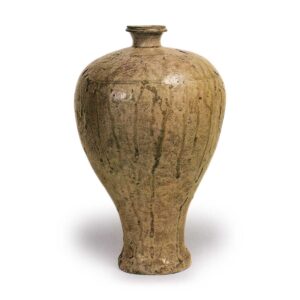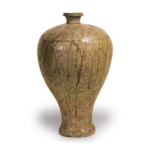
Excavated from Tagura Kiln, Goshizuka-cho, Seto City, Aichi Prefecture, Japan
13th century
Height 35.6cm, Diameter 5.5cm, Body 21.8cm, Bottom 10.5cm
This is a type of vase representative of the early Koseto period. The body is small compared to the oral portion, and the green band within is similar to that of the former type. It has a so-called “katagata” shape with broad shoulders and a narrow waist that opens slightly toward the bottom. The side edge of the bottom is chamfered by 1.3 cm, but the thickness of the bottom plate is 2.0 cm, and there is no relationship between the two. The two-tiered four-strand comb-formed chinkansen on the shoulder is one of the decorative techniques of early Kosedo ware. The base is made of high-quality gray earthenware, and the base is 2.0 cm thick and is formed by rolling up the strings on the bottom plate. The oral part is molded. The glaze is unstable and almost ash-like, and shows a flow-streaked glaze tone from the shoulder to the breast, which is characteristic of early Kosedo. The firing is extremely good. Like the aforementioned plum vase, this vessel was influenced by Chinese ceramics in the Kamakura period (1185-1333), but some believe it may have been influenced by Goryeo celadon.








